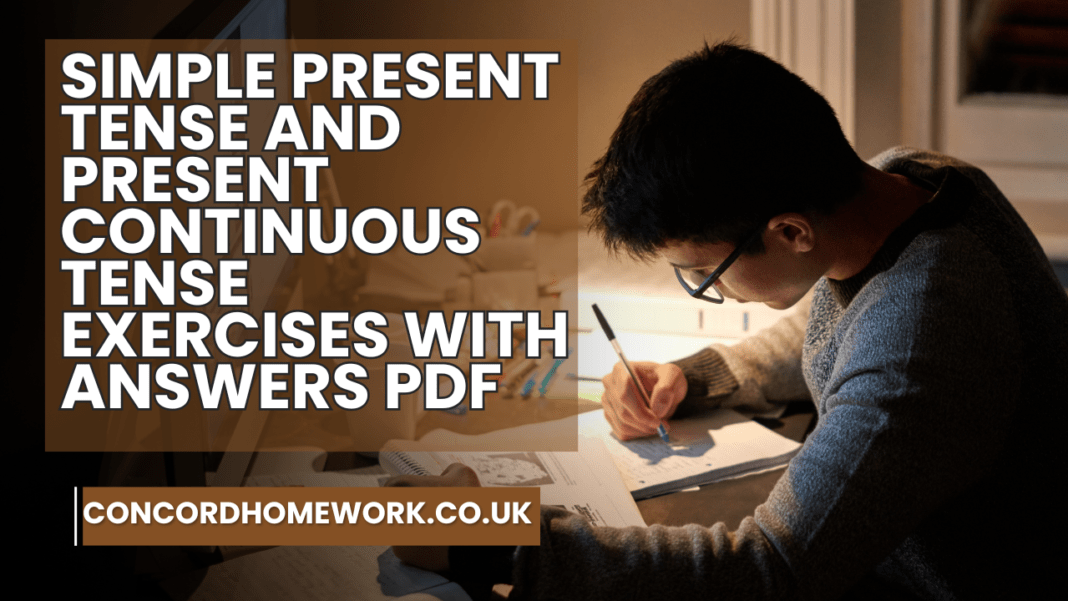
Put each verb in brackets into the most suitable present tense.
Put each verb in brackets into the most suitable present tense.
Listen and check.
This worksheet is about practicing the use of the simple present tense and the present continuous tense. Students study the exercises carefully and answer the questions. As for the second activity, students can listen to check their answers. The worksheet has got an answer key..
Let’s explore the Present Simple and Present Continuous tenses, highlighting their differences and real-life applications. I’ll provide detailed explanations, examples, and tables to help you grasp these concepts effectively.
Present Simple Tense
The present simple tense is used to express general truths, habitual actions, and fixed situations. Let’s break it down:
Structure:
| Subject | Present Simple Verb | Example |
|---|---|---|
| I/You/We/They | play | I play chess with 32 pieces. |
| He/She/It | rarely rains | It rarely rains in the desert. |
Usage:
- General Truths:
- Use the present simple to talk about facts that are always or generally true.
- Example: “The earth revolves around the sun in approximately 365 days.”
- Note: These statements hold true regardless of the specific moment.
- Use the present simple to talk about facts that are always or generally true.
- Habitual Actions:
- Describe actions that happen regularly or as part of a routine.
- Example: “I go swimming twice a week.”
- Note: These actions repeat over time.
- Describe actions that happen regularly or as part of a routine.
- Fixed Situations:
- Express states or conditions that remain constant.
- Example: “She’s very happy with her job.”
- Note: These situations don’t change frequently.
- Express states or conditions that remain constant.
Present Continuous Tense
The present continuous tense describes actions happening right now or around the current moment. Let’s explore it:
Structure:
| Subject | Present Continuous Verb | Example |
|---|---|---|
| I/You/We/They | am playing | I’m playing hockey now. |
| He/She/It | is reading | She is reading a newspaper upstairs. |
Usage:
- Actions in Progress:
- Use the present continuous to talk about actions that are ongoing at the moment.
- Example: “He’s giving a presentation to some clients.”
- Note: These actions are happening right now.
- Use the present continuous to talk about actions that are ongoing at the moment.
- Temporary Actions:
- Describe actions that are currently in progress but have a specific duration.
- Example: “I’m working from home this month.”
- Note: These actions are not permanent.
- Describe actions that are currently in progress but have a specific duration.
- General Progress (Not Happening Now):
- Discuss something generally in progress, even if it’s not actively happening at this moment.
- Example: “More and more people are feeling the effects of climate change.”
- Note: The focus is on the overall trend.
- Discuss something generally in progress, even if it’s not actively happening at this moment.
Real-Life Application:
Students can use these tenses in their daily lives:
- Present Simple:
- Describing regular activities: “I play basketball every Sunday.”
- Stating general truths: “The sun rises in the east.”
- Present Continuous:
- Expressing current actions: “I’m doing my homework.”
- Talking about temporary situations: “I’m working on a project this week.”
Time Expressions for both Simple present tense & the present continuous tense
Simple Present Tense
The Simple Present tense is used to talk about things that happen regularly, repeatedly, or all the time. We often use adverbs of frequency with this tense to state how often someone does something. Here are some common time expressions:
- Usually: Indicates a habitual action.
- Example: “I usually wake up at 7 a.m.”
- Never: Denotes the absence of an action.
- Example: “She never eats fast food.”
- Generally/Generally speaking: Describes a general truth.
- Example: “Generally, cats like to play with yarn.”
- Always: Indicates a consistent behavior.
- Example: “He always arrives early for meetings.”
- Seldom/Rarely: Expresses infrequent occurrences.
- Example: “They rarely go to the cinema.”
- Often/Frequently: Shows regularity.
- Example: “We often visit our grandparents.”
Present Continuous Tense
The Present Continuous tense describes actions happening right now or around the current moment. It emphasizes ongoing activities. Here are relevant time expressions:
- At present/Now/At the moment: Refers to actions currently in progress.
- Example: “She’s studying at present.”
- Currently: Indicates ongoing activities.
- Example: “I’m currently working on a project.”
- Right now: Emphasizes the immediate present.
- Example: “He’s right now preparing dinner.”
- At this very moment: Highlights the exact now.
- Example: “They’re at this very moment discussing the proposal.”
Remember, understanding when to use each tense helps improve communication! ????????
“Thank you for taking the time to explore this topic with us! We hope you found the information helpful and insightful. Have any thoughts, questions, or additional examples to share? We’d love to hear from you in the comments below!
Don’t forget to spread the word by sharing this blog with your friends, family, and colleagues. Together, let’s continue to learn, grow, and connect with the world around us. Happy reading and sharing!”
Follow Me On TikTok:
Follow me!????????????????
Follow me on YouTube:
-

Watch the video, then answer the question. #learnenglish #quiz #english #shorts
-

Watch the video, then answer the question. #quiz #learnenglish #english #englishquizchannel #shorts
-

Watch and learn #learnenglish #English #shorts
-

Quiz time. Watch then answer the question. #quizchallenge #quiz #riddles #puzzle #shorts
-

Watch the video, then answer the question. #LearnEnglish #QuizTime #english #shorts
-

Quiz time. Watch then answer the question. #quiz #quizchallenge #learnenglish #shorts
-

Watch the video and answer the question. #quiz #learnenglish #english #quizchallenge #shorts
-

Quiz challenge. Watch then answer. #quiz #quizchallenge #learnenglish #shorts
-

Quiz time. Watch then answer the question. #quiz #quizchallenge #shorts
-

Watch the video, then answer the question. #learnenglish #quiz #english
-

Watch the video, then answer the question. #learnenglish #quiz #english #shorts
-

Quiz challenge. Watch then answer. #quiz #quizchallenge #learnenglish #shorts
Subscribe!????????????????
What topics/worksheets do you need? Let me know in the comments below!





















This is an amazing worksheet, thanks!!!
Also, keep up the good work.
Moreover, I am the first student on this site. ????????
Thank you for the comment. Glad you enjoyed the blog. Let me know if you need any further assistance. ????